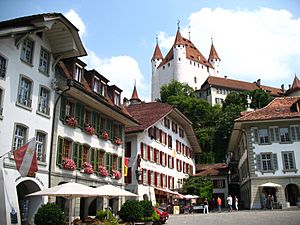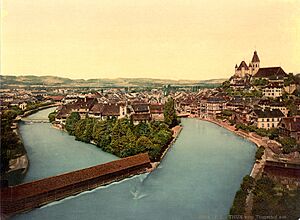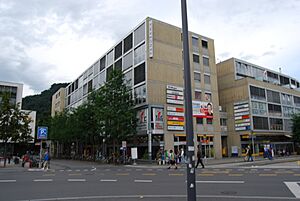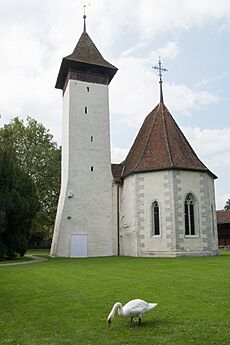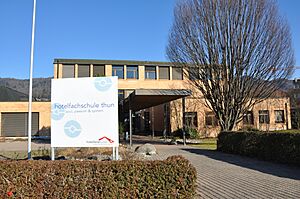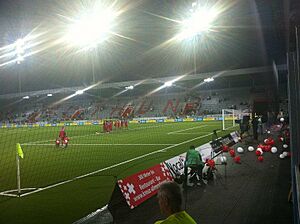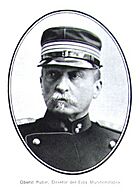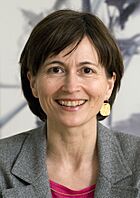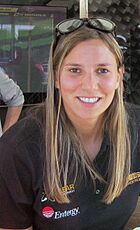Thun facts for kids
Quick facts for kids
Thun
|
||
|---|---|---|

Thun in 2012
|
||
|
||
| Country | Switzerland | |
| Canton | Bern | |
| District | Thun | |
| Area | ||
| • Total | 21.57 km2 (8.33 sq mi) | |
| Elevation
(Railway station)
|
560 m (1,840 ft) | |
| Highest elevation
(Dürrenbergwald)
|
1,172 m (3,845 ft) | |
| Lowest elevation
(Aare at Lerchenfeld)
|
552 m (1,811 ft) | |
| Population
(Dec 2020 )
|
||
| • Total | 43,476 | |
| • Density | 2,015.6/km2 (5,220.3/sq mi) | |
| Demonym(s) | German: Thuner(in) | |
| Postal code |
3600-3645
|
|
| Surrounded by | Amsoldingen, Heiligenschwendi, Heimberg, Hilterfingen, Homberg, Schwendibach, Spiez, Steffisburg, Thierachern, Uetendorf, Zwieselberg | |
Thun is a town in Switzerland. It is located in the canton of Bern. The town sits where the Aare River flows out of Lake Thun (Thunersee). This is about 30 kilometers southeast of Bern.
In 2018, nearly 45,000 people lived in Thun. About 80,000 people live in the wider area around the town.
Thun is important for its tourism. It also has industries like machine building and making precise instruments. It is home to the largest garrison (military base) in Switzerland. Food production, weapons making, and publishing are also key to Thun's economy.
The official language in Thun is German. However, most people speak a local Swiss German dialect.
Contents
Discovering Thun's Past
People have lived in the area of Thun since the Stone Age. This was around 3,000 BC. During the early Bronze Age, many settlements were built along the lake and the Aare River.
An important discovery was made at Renzenbühl. A grave there belonged to a local chief or nobleman. It held one of the richest collections of early Bronze Age items in Europe. The Thun-Renzenbühl axe, from 1800 BC, is special. It shows one of the first uses of damascening (metal inlay) in the world. The gold patterns on the axe might even have a hidden meaning, like numbers or astronomy.
The name "Thun" comes from the Celtic word Dunum. This means "fortified town" or "stronghold".
From Roman Times to the Middle Ages
Thun became part of Rome in 58 BC. This happened when Roman legions took over most of Switzerland. Soon, Thun became a main center for Roman rule in the area.
Around 400 AD, the Burgundians drove the Romans out of Thun and Switzerland. The Aare River then became a border. It separated the Christian Burgundians from the Pagan, German-speaking Alemanni people to the north.
The region was first mentioned in the 7th century. This was in a record by a Frankish monk named Fredgar. The town itself is first named "Tuno" in 1133.
Becoming Part of the Holy Roman Empire
In 1033, the Thun region joined the Holy Roman Empire. This happened when Conrad II became King of Burgundy. The emperors asked the Zähringen family, based in Bern, to control the local nobles.
Around 1190, Duke Bertold V of Zähringen built Thun castle. He also made the town bigger. After Bertold died in 1218, his lands went to Ulrich III von Kyburg.
Thun gained town rights in 1264. In 1384, the town was bought by the canton of Bern. Thun was the capital of the Canton of Oberland from 1798 to 1803. This was during the Helvetic Republic.
In 1819, a Military School started in Thun. It grew into Switzerland's main military school. Thun got connected to the railway in 1859. Telephone service became available in 1888.
Geography and Weather
How Thun is Built
The center of Thun is on the Aare River. It is just below where the river leaves Lake Thun. The town covers both sides of the river and an island in the middle. Thun spans about 21.6 square kilometers (8.3 square miles). Its borders reach up to 4 kilometers (2.5 miles) from the town center.
The town's height above sea level varies. It is about 560 meters (1,840 feet) in the town center. It goes up to 1,170 meters (3,840 feet) on its eastern edge.
About 27.9% of Thun's land is used for farming. Forests cover 20.0% of the area. Buildings and roads make up 49.9%. Rivers and lakes cover 1.3%, and 0.9% is unproductive land.
Thun's Climate
From 1981 to 2010, Thun had rain or snow on about 123.7 days each year. It received an average of 1,024 millimeters (40 inches) of precipitation. August was the wettest month, with 138 millimeters (5.4 inches) of rain or snow. It rained or snowed for about 11.7 days in August.
June had the most days with precipitation, averaging 12.9 days. However, it received slightly less rain or snow, about 132 millimeters (5.2 inches). February was the driest month. It had only 46 millimeters (1.8 inches) of precipitation over 8.3 days.
People of Thun
Population Details
Thun has a population of about 42,735 people as of 2012. About 12.3% of these people are foreign nationals. Between 2010 and 2012, the population grew by 0.3%. This growth was mainly due to people moving into the town.
Most people in Thun (90.5%) speak German as their first language. Italian is the second most common (1.8%). Albanian is third (1.3%).
In 2013, 47.5% of the population was male and 52.5% was female. Children and teenagers (0–19 years old) make up 17.5% of the population. Adults (20–64 years old) are 60.7%. Seniors (over 64 years old) are 21.8%.
In 2000, about 30.4% of the people living in Thun were born there. Another 37.4% were born in the same canton. About 14.1% were born outside Switzerland.
How Thun's Population Has Grown
The chart below shows how Thun's population has changed over time.
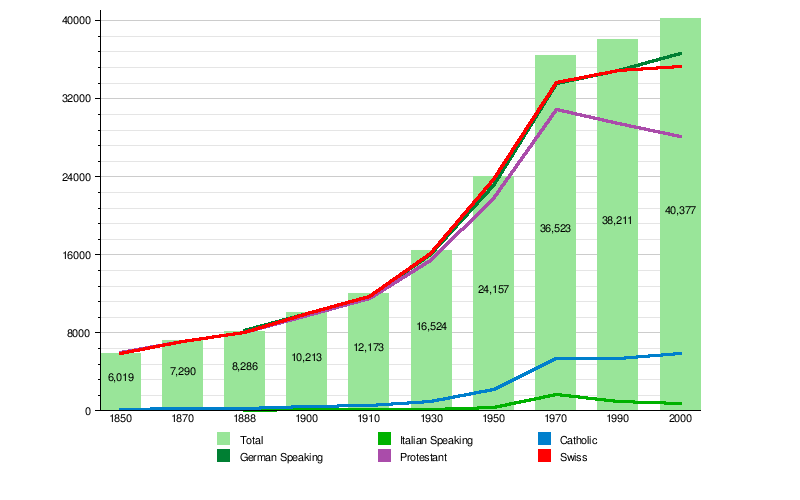
| Historic Population Data | |||||||||||
|---|---|---|---|---|---|---|---|---|---|---|---|
| Year | Total Population | German Speaking | Italian Speaking | Protestant | Catholic | Other | Jewish | Muslim | No religion given | Swiss | Non-Swiss |
| Beginning 15th century | ca. 1400 | ||||||||||
| 1764 | 1,414 | ||||||||||
| 1798 | 1,566 | ||||||||||
| 1818 | 1,936 | ||||||||||
| 1836 | 2,646 | ||||||||||
| 1850 | 6,019 | 5,897 | 121 | 1 | 5,866 | 153 | |||||
| 1870 | 7,290 | 7,076 | 236 | 6 | 7,034 | 284 | |||||
| 1888 | 8,286 | 8,154 | 13 | 8,038 | 233 | 15 | 4 | 8,007 | 279 | ||
| 1900 | 10,213 | 9,951 | 55 | 9,762 | 417 | 34 | 26 | 9,904 | 309 | ||
| 1910 | 12,173 | 11,805 | 107 | 11,540 | 537 | 96 | 27 | 11,693 | 480 | ||
| 1930 | 16,524 | 15,979 | 114 | 15,372 | 968 | 184 | 35 | 16,060 | 464 | ||
| 1950 | 24,157 | 23,105 | 273 | 21,774 | 2,150 | 233 | 34 | 23,667 | 490 | ||
| 1970 | 36,523 | 33,566 | 1,663 | 30,825 | 5,325 | 373 | 22 | 16 | 178 | 33,662 | 2,861 |
| 1990 | 38,211 | 34,944 | 895 | 29,426 | 5,314 | 3,471 | 22 | 307 | 1,093 | 34,932 | 3,279 |
| 2000 | 40,377 | 36,551 | 728 | 28,120 | 5,852 | 6,405 | 17 | 1,365 | 2,765 | 35,315 | 5,062 |
Religions in Thun
In 2000, most people in Thun (65.2%) belonged to the Swiss Reformed Church. About 14.5% were Roman Catholic. Other Christian churches made up about 4.51%.
About 3.38% of the population was Muslim. There were also people who followed Buddhism (115 individuals) and Hinduism (347 individuals). About 6.85% of the population did not belong to any church.
Thun's Economy
In 2011, Thun's unemployment rate was 2.41%. A total of 28,536 people worked in the town.
- Primary Sector: This includes farming and fishing. About 114 people worked in this area.
- Secondary Sector: This includes manufacturing and construction. About 6,625 people worked here.
- Tertiary Sector: This includes services like sales, transport, hotels, and healthcare. About 21,797 people worked in this sector.
Many people who work in Thun also live there. In 2000, 47.2% of workers both lived and worked in Thun. About 27% of workers used public transport to get to work. 41.2% used a private car.
Getting Around Thun
The main place for public transport in Thun is the Thun railway station. Here, you can find:
- Buses: These buses travel within the town and connect Thun to nearby places. They are run by Verkehrsbetriebe STI.
- Trains: BLS AG and Swiss Federal Railways (SBB CFF FFS) provide train services between cities.
- Ships: BLS also runs passenger ships on Lake Thun. These ships reach the station through the Thun ship canal.
Top Places to Visit in Thun
Thun has many interesting sights:
- Thun Castle: This castle was built in the twelfth century. It has a history museum inside. The museum shows medieval armor, weapons, and how people lived in the past.
- The Rathaus (town hall): This building was built in the 16th century.
- Lake Thun: Enjoy the beautiful views of Lake Thun and the Bernese Alps. You can see peaks like the Niederhorn, Niesen, Stockhorn, Eiger, Mönch, and Jungfrau.
- The Wocher Panorama: This is the oldest remaining panorama drawing in the world.
- The Kunstmuseum Thun: An art museum.
- Schloss Schadau: Another beautiful castle.
- Panzermuseum Thun: A museum with several armored vehicles and weapons from World War II.
Important Heritage Sites
Several places in Thun are listed as important heritage sites of national significance. These include:
- The Steamship Blüemlisalp
- The former Hotel Bellevue-Du Parc
- The former Hotel Thunerhof
- The zum Rosengarten House
- The Landsitz Bellerive
- The armory (Mannschaftskaserne)
- The former hospital at Platzschulhaus
- The Rathaus (Town council house)
- The Reformed Church of Scherzligen
- The Sammlung Historisches Armeematerial (Collection of Historical Military Equipment)
Education in Thun
In Thun, about 57.3% of people have finished upper secondary education. This is schooling that is not required. Also, 17.6% have completed higher education, like university or a specialized college (Fachhochschule).
The school system in the Canton of Bern works like this:
- One year of optional Kindergarten.
- Six years of Primary school.
- Three years of required lower Secondary school. Students are grouped by their abilities.
- After lower Secondary, students can continue schooling or start an apprenticeship.
In the 2012–13 school year, 3,923 students attended schools in Thun. Many students (18.7% in kindergarten) were not Swiss citizens. Also, many students (29.9% in kindergarten) spoke a different language at home than the classroom language.
Thun also has the Stadtbibliothek Thun library. In 2008, the library had 56,800 books and other media. It loaned out 330,316 items that year.
Sports in Thun
Thun is home to several sports teams and events:
- Soccer: FC Thun plays in the Swiss Challenge League. Their home stadium is Arena Thun. In 2005, FC Thun made it to the group stages of the UEFA Champions League.
- Handball: Wacker Thun plays in the SHL. They play at the 2,000-seat Sporthalle Lachen. They have won the Swiss championship twice.
- Ice Hockey: EHC Thun plays in the MySports League. This is the third level of Swiss hockey. They play home games at the 4,000-seat Grabengut.
- Orienteering: Thun hosted the 1981 World Orienteering Championships.
- Freestyle Kayak: Thun hosted the 2009 ICF Freestyle World Championships.
- American Football: The Thun Tigers play in Switzerland's top division, Nationalliga A (American football). They play home games at Stadion Lachen, which holds 10,000 people.
Thun in Stories
- A part of the spy novel Smiley's People by John le Carré takes place in Thun.
- Robert Walser's story Kleist in Thun is also set here.
Famous People from Thun
- 19th Century
- Eduard Rubin (1846-1920): A Swiss engineer who invented the full metal jacket bullet.
- Niklaus Gerber (1850-1914): A Swiss dairy chemist and businessman.
- Edward Bullough (1880–1934): An English scholar of languages and aesthetics.
- Renée Schwarzenbach-Wille (1883–1959): A horse lover, photographer, and music lover.
- Markus Feldmann (1897–1958): A Swiss politician who was a member of the Swiss Federal Council.
- 20th Century
- Drs. P (Heinz Hermann Polzer) (1919–2015): A Swiss singer, poet, and writer in Dutch.
- Jean Ziegler (born 1934): A politician, professor, and author.
- Guy Bovet (born 1942): A Swiss organist and composer.
- Alexandre Dubach (born 1955): A Swiss violinist.
- Peter Maurer (born 1956): President of the International Committee of the Red Cross since 2012.
- Stefan Haenni (born 1958): A Swiss painter and crime novel writer.
- Regula Rytz (born 1962): A politician, sociologist, and historian.
- Philipp Fankhauser (born 1964): A Swiss blues musician and songwriter.
- Sandra Moser (born 1969): A Swiss stage and film actress.
- Sports Figures
- Heinz Schneiter (1935–2017): A football player and manager.
- Hanspeter Latour (born 1947): A football manager and former goalkeeper.
- Walter Balmer (1948-2010): An international footballer who played 20 games for the national team.
- Ralph Pichler (born 1954): A bobsledder who competed in the 1984 Winter Olympics.
- Markus Eggler (born 1969): A retired curler who competed in the 2002 and 2010 Winter Olympics.
- Bruno Kernen (born 1972): An alpine ski racer who won a bronze medal in the 2006 Winter Olympics.
- Ivan Rieder (born 1976): A Nordic combined skier who competed in the 2006 Winter Olympics.
- Marc Schneider (born 1980): A footballer who played over 330 games. He is currently the manager of FC Thun.
- Zdravko Kuzmanovic (born 1987): A footballer.
- Simona de Silvestro (born 1988): A race car driver.
- Stjepan Kukuruzović (born 1989): A Swiss-born Croatian footballer.
- Nico Müller (born 1992): A race car driver.
See Also
 In Spanish: Thun para niños
In Spanish: Thun para niños







